 |
New York
Architecture Images- Midtown
Madison Square Garden Center
|
|||
|
architect |
Charles Luckman | |||
|
location |
W31 to W33, Seventh to Eighth Aves. | |||
|
date |
February 14, 1968 | |||
|
style |
International Style II | |||
|
construction |
precast concrete panels cladding | |||
|
type |
Theater | |||
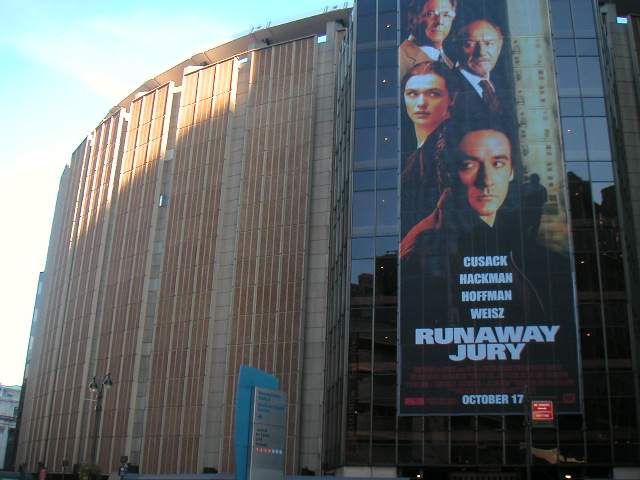 |
||||
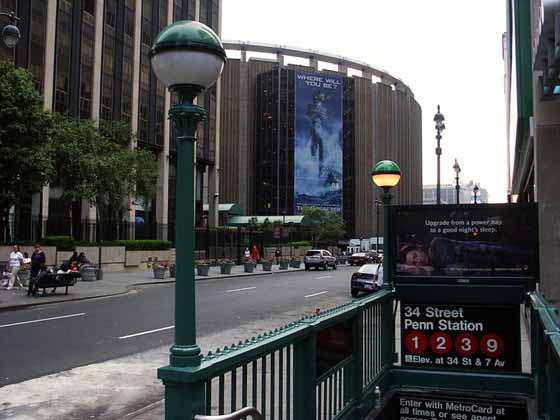 |
||||
| Image- with special thanks to Rick Stasel | ||||
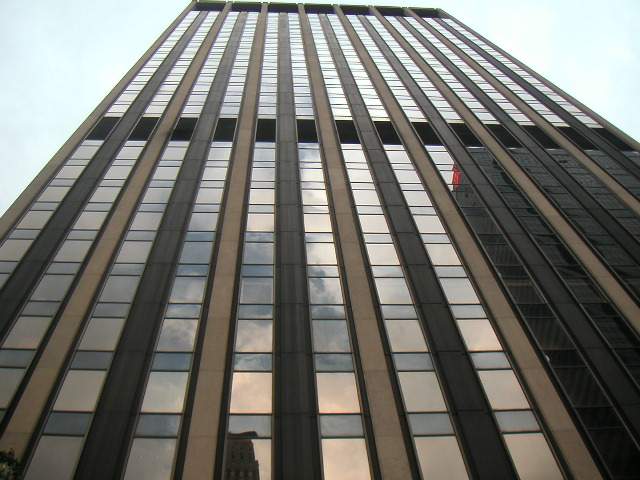 |
||||
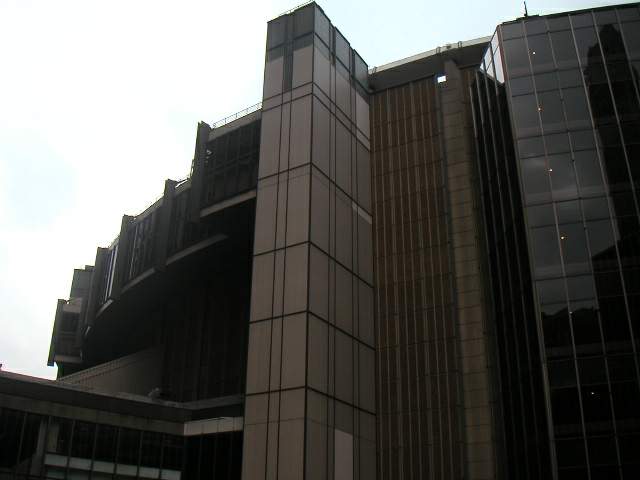 |
||||
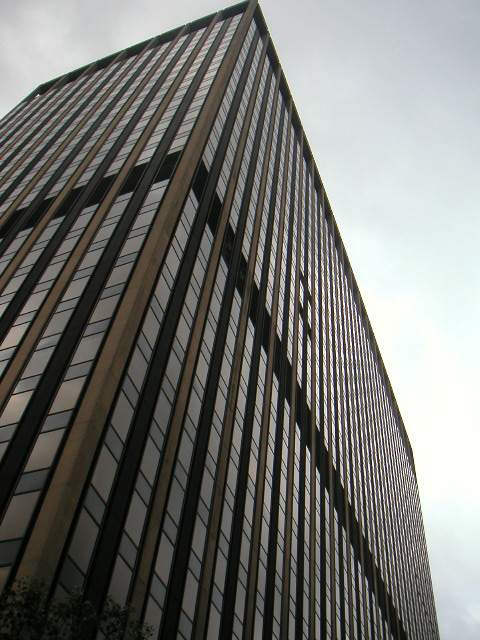 |
||||
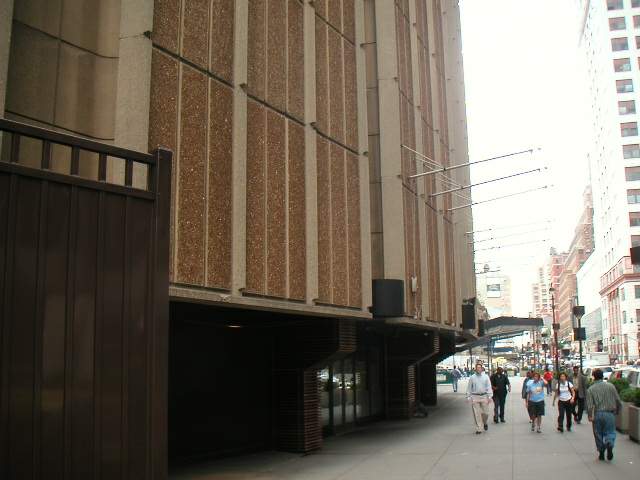 |
||||
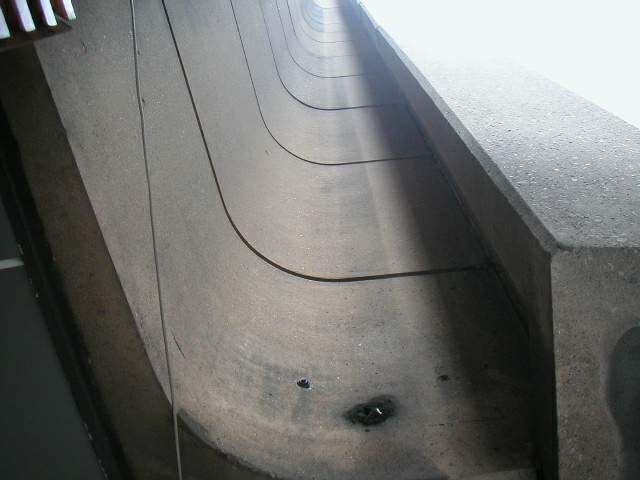 |
||||
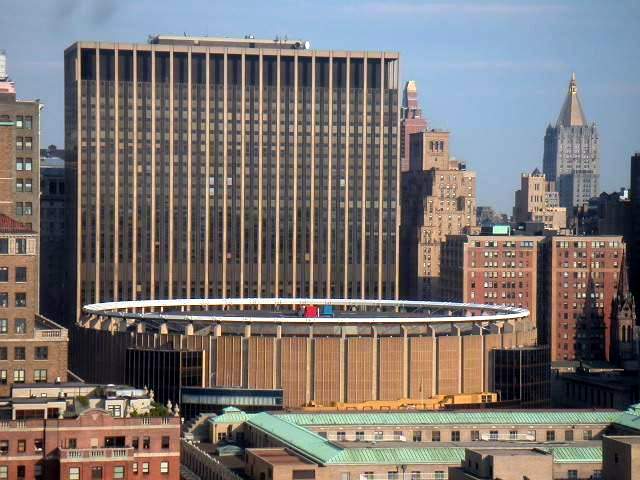 |
||||
 |
||||
| 1968 advertisement showing architect's model of the final plan for the Madison Square Garden Center complex. The neighborhood is known as Pennsylvania Plaza. | ||||
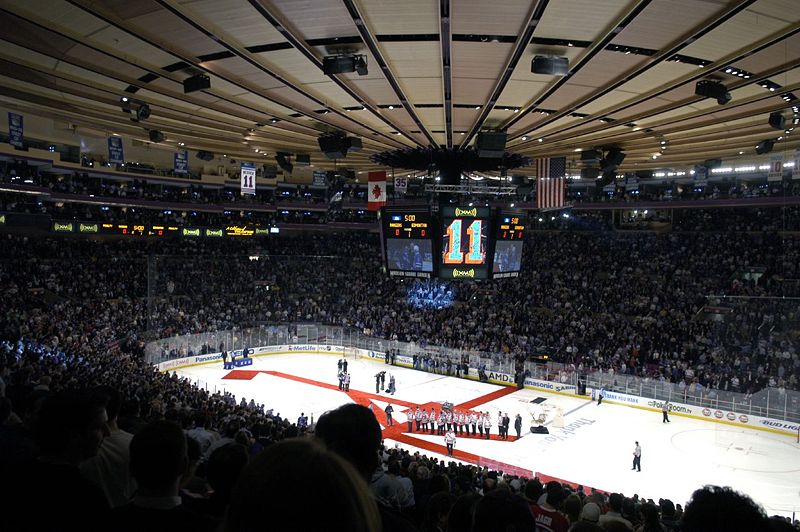 |
||||
| The Garden during "Mark Messier Night", January 12, 2006. | ||||
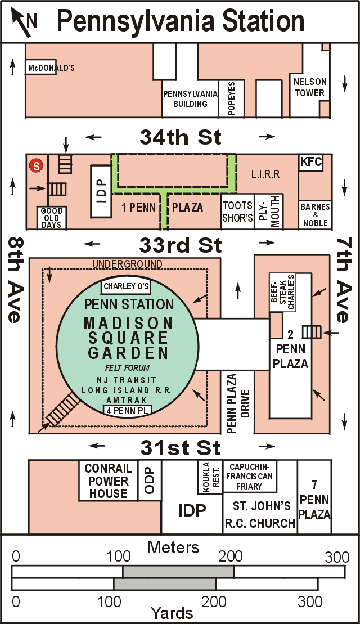 |
||||
|
notes |
see also 1 Penn Plaza | |||
|
Madison Square Garden, often abbreviated as MSG, known colloquially simply
as The Garden or The World's Most Famous Arena, has been the name of
four arenas in New York City, United States. It is also the name of the
entity which owns the arena and several of the professional sports
franchises which play there. There have been four incarnations of the
arena. The first two were located at the Northeast corner of Madison
Square (Madison Ave. & 26th St.) from which the arena derived its name.
Subsequently a new 17,000-seat Garden (opened December 15, 1925) was
built at 50th Street and 8th Avenue, and the current Garden (opened
February 14, 1968) is at 7th Avenue between 31st and 33rd Streets,
situated on top of Pennsylvania Station. The arena lends its name to the Madison Square Garden Network, a cable television network that broadcasts most sporting events that are held in the Garden, as well as concerts and entertainment events that have taken place at the venue. It is controlled by the Madison Square Garden, L.P. subsidiary of Cablevision. History Madison Square Garden derives its name from the park where the first two gardens were located (Madison Square) on Madison Avenue at 26th Street. As the venue moved to new locations the name still stuck, although since 1925 Madison Square Garden has been neither a garden nor on Madison Square. 1879-1890 Madison Square Garden I.The location of the first Madison Square Garden (now known as Madison Square Garden I), was at 26th Street and Madison Avenue. The site was formerly occupied by the passenger depot of the New York and Harlem Railroad. When the depot was moved to what is now the site of Grand Central Terminal in 1871, the old depot was sold to P.T. Barnum who converted it into "Barnum's Monster Classical and Geological Hippodrome." In 1876 Barnum's was converted into "Gilmore's Garden," an open air arena named in honor of Patrick Gilmore.[1] Gilmore was America's most well-known bandmaster at the time. His most famous composition was "When Johnny Comes Marching Home." Finally, Gilmore's Garden was renamed "Madison Square Garden" by William Henry Vanderbilt and the facility was reopened to the public on May 31, 1879. The first Garden was originally designed for the sport of track cycling. This is still remembered in the name of the Madison event. 1890-1925 Madison Square Garden II.The second Madison Square Garden (now known as Madison Square Garden II), also located at 26th and Madison Avenue was designed by Stanford White, who would later be killed at the Garden's rooftop restaurant. White kept an apartment, site of the famous red velvet swing, in the building. The new structure was 200 feet by 485 feet of Moorish architecture with a minaret-like tower soaring 32 stories over Madison Square Park and was the city's second tallest building. The Garden's main hall, was the largest in the world, measured 200 by 350 feet with permanent seating for 8,000 people and floor space for thousands more. Topping the garden was a statue of Diana, by Augustus Saint-Gaudens. The original bronze statue was 18 ft. tall and weighed 1,800 lbs., but spun with the wind. It was placed on top of the tower in 1891, but was soon thought to be too large by Saint-Gaudens and White, the architect. (It was removed and placed on top of a building at The World's Columbian Exhibition in Chicago - the bottom half was destroyed by a fire after the close of the Exhibition, and the top half was lost.) In 1893 a guilded, hollow copper, 2nd version of Diana, replaced the original on top of the Garden tower. This 2nd version was 13 ft. tall and is now at the Philadelphia Museum of Art, and a copy is in the Metropolitan Museum of Art. Saint-Gaudens made several smaller variants in bronze, one of which was on display in the entryway of Madison Square Garden III, and also in a similar location in the current Garden, MSG IV. It hosted the 1924 Democratic National Convention, which nominated John W. Davis after 103 ballots. Afterwards, it was torn down to make way for the landmark New York Life Insurance Building. White was a member of the architecture firm McKim, Mead and White which designed Pennsylvania Station which was torn down to make way for MSG IV. The firm also designed the James Farley Post Office which is being proposed as the anchor for the proposed new Pennsylvania Station as well as the proposed MSG V. 1925-1968 1925-26 New York Americans game program cover for hockey at Madison Square GardenThe third garden, now known as Madison Square Garden III, was built on 50th Street and Eighth Avenue by boxing promoter Tex Rickard and was dubbed "The House That Tex Built." The New York Rangers got their name in a wordplay on Tex's name (e.g., Tex's Rangers). It was built in 249 days on the site of the city's street car barns. However, the Rangers were not the first NHL team to play at the Garden. The New York Americans had begun play in 1925 and were so wildly successful at the gate that Rickard wanted his own team also. The Rangers were founded in 1926 and both teams played at the Garden until the Americans folded in 1942, the Rangers having stolen their commercial success with their own success on the ice (winning 3 Stanley Cups between 1928 and 1940). This was the basis for the "Curse" that supposedly prevented the Rangers from winning the Stanley Cup again until 1994. While the Ringling Bros. and Barnum & Bailey Circus had debuted at the Garden in 1919, the third garden saw large numbers of performances. The circus was so important to the Garden that when the Rangers played in the 1928 Stanley Cup Finals, the team was forced to play all games on the road (the Rangers won the series anyway). The circus would continue to perform as often as three times daily, repeatedly knocking the Rangers out of the Garden at playoff time, throughout the life of the third Garden. Even at the fourth Garden, games would have to begin as late as 9:00 p.m. to accommodate the circus. The Circus Acrobatics were very dramatic including acts in the Rings as well as on the high wire and trapeze. One dramatic act which was only performed in the Garden, and not taken on the road with the traveling Circus, involved Blinc Candlin, a Hudson, New York fireman, who rode his (already antique) 1880s High Wheel bicycle on the high wire every season for over 2 decades starting in the 1910s and running well through the 1930s. In 1928 Rickard built "Boston Madison Square Garden." The name got clipped to Boston Garden. Boxing was Madison Square Garden III's principal claim to fame. The building exterior in contrast to the ornate towers of the first two Garden was a simple box. Its most distinctive feature was its ornate marquee that was above the main entrance, with its seemingly endless abbreviations (Tomw., V/S, Rgrs, Tonite, Thru, etc.) Even the name was abbreviated: Madison Sq. Garden. On January 17, 1941, 23,190 people witnessed Fritzie Zivic successful welterweight defense against Henry Armstrong. That is the biggest attendance record of any of the Gardens. MSG III was featured prominently in the 2005 Ron Howard film Cinderella Man (although exterior montage shots glorified it by placing it against the Times Square signs on Broadway when it was in fact one block west). The NHL New York Rangers were a prime tenant of the 50th St. MSG from 1926 to 1968 (1932-33 Team Picture)It hosted the only indoor bout in the career of Jack Dempsey. It cost $4.75 million to build; this one hosted seven NCAA men's basketball championships between 1943 and 1950. City College of New York (CCNY) was one of the first schools banned from playing at MSG due to the 1951 CCNY Point Shaving Scandal.[2] It also hosted the NBA All-Star Game in 1954 and 1955. Ironically one type of event that was never held in the 50th St. MSG (except in the movies) was a national Democratic or Republican nominating convention as neither of these parties met in New York to select their candidates for President and Vice President of the United States between 1924 and 1976. The third Garden had poor sightlines, especially for hockey, and fans sitting in the upper deck could count on having some portion of the ice obstructed, unless they sat in the first row. The fact that there was poor ventilation and that smoking was permitted often led to a haze in the upper portions of the Garden. When it was torn down, there was a proposal to build the world's tallest building on its site prompting a major battle in its Hell's Kitchen neighborhood that ultimately resulted in strict height restrictions. The space remained a parking lot though until 1989 when Worldwide Plaza designed by David Childs of Skidmore, Owings and Merrill opened. Madison Square Garden Bowl Madison Square Garden Bowl (a.k.a. Long Island City Bowl) on June 21, 1932. The occasion is Jack Sharkey vs. Max Schmeling. Final paid attendance: 61,863.Madison Square built an open air arena, the Madison Square Garden Bowl at 48th and Northern Boulevard in Long Island City in 1932 that could seat 72,000. This was the site where James Braddock defeated Max Baer for the World Heavyweight title on June 13, 1935 that was dramatized in the film Cinderella Man. Braddock was born on West 48th Street in Hell's Kitchen just a few blocks from the West 49th Street location of MSGIII. Braddock's first come back fight against John "Corn" Griffin was also in the venue. Jack Sharkey and Primo Carnera also captured the heavyweight crown in the 1930s at the Madison Square Garden Bowl. The bowl was torn down after World War II to make way for U.S. Steel and Ronzoni Macaroni Company factories. They in turn were torn down and the area is now home to a shopping center. 1968-present 1968 advertisement showing architect's model of the final plan for the Madison Square Garden Center complex. The neighborhood is known as Pennsylvania Plaza. The original Pennsylvania Station in New York City, located on the site where Madison Square Garden sits today.On February 11, 1968 Madison Square Garden IV opened after the Pennsylvania Railroad tore down Pennsylvania Station (New York City) and continued railway traffic underneath. The new structure was one of the first of its kind to be built above an active railroad system. It was an engineering feat constructed by R.E. McKee of El Paso, Texas. Public outcry over the demolished Beaux-Arts structure led to the creation of the New York City Landmarks Preservation Commission. The current Garden is the hub of Madison Square Garden Center in the office and entertainment complex formally addressed as Pennsylvania Plaza and commonly known as "Penn Plaza" for the railroad station atop which the complex is located. In 1972, the Garden's Chairman, Irving Mitchell Felt, suggested moving the Knicks and the Rangers to what was a proposed venue in the New Jersey Meadows (now completed and known as Meadowlands Sports Complex or Izod Center.) This location now hosts its own NBA team (New Jersey Nets) and from 1981-2007, the NHL's New Jersey Devils. The NFL's New York Giants were the only established New York-named team that actually did move there, and they were later joined by the Jets. Felt's efforts fueled controversy between the Garden and New York City over Real Estate Tax. The scenario again flared in 1980 when a reported threat by the Garden supposed a similar move of popular sports teams in an effort to again challenge property tax. Efforts were ignored by city leaders. In 1991, Garden owners spent $200 million to renovate facilities and add 89 suites. The process involved hundreds of upper-tier seats removed to make way. In 2004-2005 Cablevision (the Garden's owner) battled with the City of New York over proposed West Side Stadium which would compete with the Garden. New stadium proposals halted; and Cablevision announced its own plans to raze the Garden, replace it with high-rise commercial buildings and build a new Garden nearby. New arena As of September 2007, the Garden's current owner, Cablevision, has plans to build a fifth Garden. If the project moves forward, a new Garden would be built at the western end of the James Farley Post Office / Farley Annex, on 33rd Street and Ninth Avenue across the street, which is also eyed for a western expansion of Pennsylvania Station. The James Farley Post Office is a National Historic Landmark and is named in honor of former Postmaster General and New York State Athletic/Boxing Commissioner James Farley. The Farley Garden, which would remain home to the Rangers and the Knicks, would feature wide concourses with stores and restaurants, luxury boxes with better sight lines for basketball and hockey games, a museum, and a hall of fame. The current Garden would be torn down to be replaced with a new Penn Station.[3] Present operations The Garden during "Mark Messier Night", January 12, 2006.The present Garden hosts approximately 320 events a year but it is best known as the home of the New York Knicks of the NBA and New York Rangers of the NHL. The aforementioned professional sports teams play their home games in the arena and are owned by the Garden itself. It also hosts New York Liberty (WNBA) home games (also owned by the Garden), the Ringling Brothers and Barnum and Bailey Circus when it comes to New York City (although Continental Airlines Arena and Nassau Coliseum also host the circus each year), selected home games for the St. John's men's Red Storm (college basketball), the Big East Men's Basketball Conference Tournament, the annual pre and postseason NIT tournaments, the NBA Draft, the Millrose Games athletics meet, and almost any other kind of indoor activity that draws large audiences, such as the 2004 Republican National Convention. It has previously hosted the 1976, 1980 and 1992 Democratic National Conventions, and hosted the NFL Draft for many years (now held at Garden-leased Radio City Music Hall). In 2008, all five home games for the New York Titans will be played at the Garden. The "sixth" home game will be at Sovereign Bank Arena in Trenton, New Jersey. The other two games were lost to the Buffalo Bandits and the Toronto Rock due to scheduling difficulties following the cancellation and subsequent resurrection of the 2008 NLL Season. MSG hosted the 1994 NHL All-Star Game and 1998 NBA All-Star Game, three WNBA All-Star Games (1999, 2003 and 2006), and a portion of the 1996 World Cup of Hockey. Connecticut-based World Wrestling Entertainment considers it a home arena as well, due to the fact that all generations of the McMahon family, including Vince McMahon's father and grandfather, have promoted shows at the Garden. MSG has hosted several WrestleMania and SummerSlam events, two Survivor Series events and the 2000 and 2008 Royal Rumble. More WWE Championships have been won at MSG than any other arena. WWE's strong relationship with Madison Square Garden prevented competitor World Championship Wrestling (WCW) from ever having a show at the Garden.[citation needed] In 2005, WWE severed business ties with the arena because WWE felt that increased rental costs would prevent them from making a profit in the building. However, over a year later, World Wrestling Entertainment temporarily patched things up with MSG and the hiatus ended with a September 11, 2006 edition of WWE Raw. Though they pulled the 20th installment of SummerSlam, which would have been held at the Garden on August 26, 2007. (It was held at the Continental Airlines Arena) WWE continues to make occasional appearances at MSG, and returned for the 2008 Royal Rumble in January. MSG is also known for its place in the history of boxing. Many of boxing's biggest fights were held at Madison Square Garden, including many of Joe Louis, the Roberto Duran-Ken Buchanan affair, and the second Joe Frazier-Muhammad Ali bouts. In March 1947, Herbie Kronowitz of Brooklyn and Artie Levine of Cleveland thrilled a crowd of 12,000 during a 10-round battle between the two Jewish fighters. Levine won the decision, although Kronowitz claimed that while Levine "won the decision. There was no question that I won the fight." Before promoters such as Don King and Bob Arum moved boxing to Las Vegas, Madison Square Garden was considered the mecca of boxing. The original 18½' × 18½' ring, which was brought from the second and third generation of the Garden, was officially retired on September 19, 2007 and donated to the International Boxing Hall of Fame after 82 years of service. A 20' × 20' ring replaced it beginning on October 6 of that same year. Many large popular-music concerts in New York City take place in Madison Square Garden. Particularly famous ones include The Concert for New York City following the September 11 attacks and John Lennon's final concert appearance before his murder in 1980. The Garden usually hosts a concert each year on New Years Eve, with the Knicks and Rangers usually playing on the road. Many musical acts released seminal live albums recorded at MSG, including Led Zeppelin, Fania All Stars, Bruce Springsteen, Frank Sinatra, Billy Joel, Phish, Elton John, Elvis Presley, Madonna, Mary J Blige, U2, The Rolling Stones, Britney Spears, Shakira,Slayer, Kelly Rowland, Gareth Gates, Justin Timberlake, NSYNC, Cher, Christina Aguilera, Spice Girls The Who, Beyonce, Enrique Iglesias, Ricky Martin, and Barbra Streisand. Other artists, such as Pearl Jam, Mariah Carey, and O.A.R. and Marc Anthony have released DVDs showing their live performances at the Garden. Some of these releases, such as by Cream and Michael Jackson, show special anniversary or reunion concerts at the venue. An extensive list of live performances played at the venue is included below. The arena is also used for other special events, including Tennis, Circus, and Wrestling events. The New York Police Academy, New York University and Yeshiva University also hold their annual graduation ceremonies at Madison Square Garden. It has become the New York site of the annual Grammy Awards (which are normally held in Los Angeles) and hosted the 2005 Country Music Association Awards (normally held in Nashville). The Big East Conference men's basketball tournament has been held at MSG every year since 1983 making it the longest period a conference tournament has been held at a single location. Seating Seating in the present Madison Square Garden is arranged in six ascending levels. The first level, available for basketball games and concerts, but not for hockey games, is the "floor" or "court-side" seating. Next above this is the loge seating, followed by the 100-level and 200-level promenades, the 300-level promenade, and the 400-level or mezzanine. The seats of these levels originally bore the colors red, orange, yellow, green, and blue, respectively; however, this color scheme has since been changed, mainly because the "blue seats" had become synonymous with rowdy behavior by fans, particularly those attending New York Rangers hockey games. It was a common sight for Rangers fans to set fire to the jerseys of fans from visiting teams, especially those from the New York Islanders, Boston Bruins, and the Philadelphia Flyers. Rangers fans in the blue seats would defend their home from the invading hordes of visiting teams' fans at all costs. Fights were constantly occurring, and ushers would often let Rangers fans get their last punches or kicks in before hauling away the opposing fan. Today, the Garden is not as hostile for opposing fans to visit. The 400 level known as the "blue seats" still consists of many diehard fans and they are just as passionate as they were when the seats were colored. Tickets for events at MSG are hard to come by, especially for the New York Rangers who sell out nearly every single game. For hockey, the Garden seats 18,200; for basketball, 19,763; and for concerts 20,000 center stage, 19,522 end-stage. The arena features 20,976 square feet (1949 m²) of arena floor space. Because all of the seats, except the 400 level, are in one monolithic grandstand, distance from the arena floor is significant from the ends of the arena. Also, the rows rise much more gradually than other North American arenas, which can cause impaired sightlines, especially when sitting behind tall spectators or one of the concourses. Other venues Today's Madison Square Garden is more than just the arena. Other venues at the Garden include: The WaMu Theater at Madison Square Garden, which seats between 2,000 and 5,600 for concerts and can also be used for meetings, stage shows, and graduation ceremonies, and was also the traditional home of the NFL Draft until 2005, when it moved to the Jacob Javits Convention Center after MSG management opposed a new stadium for the New York Jets. It also occasionally hosts major boxing matches on nights when the main arena is unavailable. No seat is more than 177 feet (54 m) from the 30-foot-by-64-foot stage. The theatre has a relatively low 20 foot ceiling at stage level[4] and all of its seating except for boxes on the two side walls is on one level slanted back from the stage. There is an 8,000-square-foot lobby at the theater. When the current Garden opened in 1968, the Theater was known as the Felt Forum, in honor of then president Irving Felt. In the early 1990s, it was renamed the Paramount to be the successor to the Paramount Theater (New York City) in Times Square which had been converted to an office tower. Paramount Communications (which had previously been known as Gulf & Western) owned the Garden. The theater received its next name of The Theater at Madison Square Garden in the mid-90s, after Viacom bought Paramount, and sold the MSG properties to a group consisting of ITT and Cablevision, which each owned 50% of the Garden. In 1997, ITT sold their share to Cablevision, giving the cable company full control of the venue. On May 17, 2007, the theater received its current name due to a naming rights deal with Washington Mutual. The 36,000-square-foot Expo Center (formerly known as "The Rotunda") is used for trade shows, cat shows, stamp shows, often in combination with the arena, banquets, and receptions. A 9,500-square-foot terrace and two restaurants: the Garden Club and the Play-by-Play. Other corporate operations In addition to the Garden itself, Madison Square Garden, L.P. also operates two theaters in Manhattan: Radio City Music Hall and the Beacon Theater. In 2008, they took over operations of the Chicago Theatre, marking the first time MSG has operated a facility outside New York City. Past Corporate Operations Madison Square Garden also used to operate the XL Center (forerly known as the Hartford Civic Center) and Rentschler Field under contract with the state of Connecticut until the 2007 season when it was replaced by Northland/Anschutz Entertainment Group.[5][6] The XL Center, an indoor arena in Hartford, Connecticut, is home to the Rangers AHL affiliate, the Hartford Wolf Pack. The arena also serves as the part-time home of the men's and women's basketball teams of the University of Connecticut. Rentschler Field, a stadium in East Hartford, hosts UConn's college football team. It was built for the University of Connecticut after a plan to build a larger stadium that would have accommodated both the Huskies and New England Patriots fell through. It also hosts various concerts and soccer matches.[7] Notable firsts February 12, 1879 - The first artificial ice rink in North America opens at the Garden. 1902 - The first indoor professional American football game is played. 1934 - The first college basketball game at the Garden is played, between the University of Notre Dame and New York University. February 28, 1940 - Basketball is televised for the first time (Fordham University vs. the University of Pittsburgh). March 19, 1954 - Joey Giardello knocks out Willie Tory in round seven at the Garden in the first televised prize boxing fight shown in color. February 8, 10, 11, 1979 - The Challenge Cup, a three-game series between the All-Stars of the National Hockey League and the Soviet National Team took place at the Garden. The Soviets won, two games to one. March 31, 1985 - The World Wrestling Federation (now known as World Wrestling Entertainment or WWE), presents the inaugural WrestleMania. The annual event would return to Madison Square Garden in 1994 and 2004 for WrestleMania X and WrestleMania XX, celebrating the 10th and 20th anniversaries of WrestleMania. August 29, 1988 - The WWE presents the first SummerSlam event. The annual events would return to Madison Square Garden for SummerSlam 1991 and SummerSlam 1998. June 14, 1994 - After 54 years, the New York Rangers win the Stanley Cup at Madison Square Garden. It is the first time that a Stanley Cup has been won by the Rangers at the Garden. June 29, 1997 - The New York Liberty professional women's basketball team plays its first home game - the first WNBA game to be played at Madison Square Garden.[8] March 1, 2003 - Quinnipiac University defeats the University of Connecticut 4-3 in the first college hockey game played at Madison Square Garden since 1977. July 13-15, 2007 - Popular Boston-based indie band Dispatch, sold out MSG for three nights in a row and became the first independent band to either headline, or sell out MSG. Historic events Political and other events Throughout its long history, the Garden has been involved in its share of historical events. These events have included famous political rallies and celebrations. The 1924, 1976, 1980, and 1992 Democratic National Conventions were held at MSG. On February 20, 1939, A large German-American Bund convention was held prompting riots and protests in and around the arena by American Jews. Former Republican Party presidential candidate Wendell Willkie led 20,000 African-Americans on June 7, 1943, the largest Civil Rights rally of its time, in demanding equal rights and victory in the war against Hitler. President John F. Kennedy's 45th birthday celebration took place at the Garden on May 19, 1962. During it, Marilyn Monroe sang her now infamous Happy Birthday, Mr. President. On July 1, 1982 Rev. and Mrs. Sun Myung Moon held a Blessing Ceremony in the Garden for 2075 couples. This event attracted a lot of public and media attention (including a story in Life Magazine), often being called a "mass wedding." The 2004 Republican National Convention at MSG marked the first time that the Republican party held their convention in New York City. Concerts and live performances Since 1968, Madison Square Garden has been host to a number of concerts and live performances. Listed in chronological order with name of artist and date of performance In August, 1969, the Jackson 5 made their first television appearance, singing The Isley Brothers' "It's Your Thing" at the Miss Black America Pageant at MSG. The Rolling Stones 1970 live album Get Yer Ya Ya's Out was made with the Stones performances at MSG on November 27 and 28th 1969, during their legendary 1969 North American Tour. A twelve-act show dubbed the Winter Festival for Peace took place at MSG on January 28, 1970. On August 1, 1971, George Harrison held his Concert For Bangladesh. This historic event was the first special benefit concert to raise funds for charity (in this case, the country of Bangladesh, which was at that time in a severe and desperate state). There were two concerts held that day, with one taking place at 2:30pm and the other at 7:00 pm. The show featured artists such as Harrison, Ravi Shankar, Eric Clapton, Bob Dylan, Ringo Starr, Billy Preston, and Klaus Voormann, to name a few. A live album of the concert was released in 1972. In June of 1972, Elvis Presley made his first and only appearances in New York City at the Garden. Elvis played four shows to 80,000 people, which at the time was a record for the venue. A week after the shows an album of the Saturday evening performance was rushed to release making it the fastest turnaround between a live performance and its recorded release. To mark the 25th anniversary of Elvis' Garden shows, a recording of the Saturday afternoon performance was released entitled An Afternoon in the Garden. John Lennon performed a concert at The Garden on 30 August 1972 which was professionally recorded and posthumously released on the 1986 album Live in New York City. English rock band Led Zeppelin filmed and recorded their live album, and for many years, only live album and accompanying concert film, The Song Remains the Same, at The Garden during their 1973 U.S. tour. Additional footage from these concerts was released in 2003 on the Led Zeppelin DVD. In June of 1974, The Who played 4 sold-out dates. A single radio announcement during a December 1973 radio broadcast was enough to sell out the shows in a matter of hours. In October 1974, to cap his comeback after his retirement in 1971 Frank Sinatra played in front of 20,000 fans at the Garden in a show dubbed "The Main Event" that was broadcast nationally and internationally. On November 28, 1974, John Lennon made a surprise guest appearance at an Elton John concert - Lennon's last ever concert appearance. They sang together as a duet on "Lucy in the Sky with Diamonds", "Whatever Gets You Thru the Night" and "I Saw Her Standing There". The concert was released as the "There" portion of John's 1976 live album Here and There. In June 1977 Led Zeppelin performed six sold out concerts at The Garden. The band spent no money on advertising for the gigs, relying on street demand to sell out the shows. Enough ticket applications were received to sell out a further two nights, had time permitted. In July 1977, English rock band Pink Floyd performed at MSG for the first time in their then ten year recording career, playing four consecutive sold out nights from July 1 through July 4 on the final North American dates on their Animals tour. The show on July 1 saw problems between the band and local lighting technicians, whom they had to use instead of their own lighting crew due to union technicalities, and on July 3 when fans lit off fireworks which disrupted the Pink Floyd's performance. The band (minus Roger Waters) would not play the venue again until the 1987 A Momentary Lapse of Reason tour, when the shows ran a lot more smoothly. On June 17, 1978 reggae superstar Bob Marley raised the profile of reggae music in America with his performance at the Garden. In 1980 Marley played two concerts at the venue as the opener of The Commodores; the performances were sold out, but the Garden was almost empty after Marley's show. The day after Marley, already fatally ill, collapsed while jogging in Central Park and performed one last concert in Pittsburgh before canceling the tour. Marley died months later of cancer. On July 29, 1978 Genesis made their second appearance at the venue. Although now without guitarist Steve Hackett, original front man Peter Gabriel did attend the show and joined the band for an encore of their seminal hit single, "I Know What I Like". Genesis played this venue again on all subsequent US tours except for the 1992 We Can't Dance tour. In October 1978 Jethro Tull filmed a concert at this venue on their Bursting Out tour which aired on television. Some parts were released on the re-issued Thick as a Brick album and various concert videos. These concerts were of note as Tull's leader Ian Anderson's friend Tony Williams filled in for then-Tull bass player John Glascock, who was suffering from ailing health (Glascock would pass away in 1979). During Queen's show in November of 1978 the band had numerous naked women on stage riding bicycles during their song "Bicycle Race" This stunt attracted considerable media attention. Woodstock '79: a rock concert in honor of the 10th Anniversary of the original Woodstock Festival. In May 1981 Rush performed at MSG for the first time in their then seven year career on their Moving Pictures tour. The band would subsequently perform here again in 1982 (two shows on their Signals tour), 1984, 1988, 1991, 1994 (two shows on their Counterparts tour), 2002 and as recent as September of 2007. On New Year's Eve, 1982 Billy Joel played his first sold out new year's eve concert as well as ended his Nylon Curtain tour on the same night at The Garden. On May 14, 1988, the Atlantic Records 40th Anniversary celebrations were held at The Garden, consisting of a non-stop concert lasting almost 13 hours. Those performing included Led Zeppelin, Yes, Genesis, Iron Butterfly, The Rascals, Crosby, Stills & Nash, Foreigner, Paul Rodgers, Bob Geldof, Booker T. Jones, Wilson Pickett, The Coasters, The Spinners, Peabo Bryson, Dan Aykroyd, Roberta Flack, Manhattan Transfer, Debbie Gibson, The Bee Gees, Ruth Brown, LaVern Baker, Ben E. King, and Vanilla Fudge. Comedian Andrew Dice Clay became the first comic to do two sold out shows in a row in 1991 in a film entitled Dice Rules. In 1993 Luis Miguel became the first Latin artist to sell out at the Garden and received a special recognition during the middle of the show. In 1994 Barbra Streisand did six shows here and recorded her album The Concert here. In 1994, Notorious B.I.G. (Biggie Smalls), Tupac Shakur, Shyheim and Big Daddy Kane freestyled live. On 10 October 1995, Mariah Carey performed at The Garden, which was filmed and released on the DVD/Home Video Fantasy: Mariah Carey at Madison Square Garden. On December 31, 1995, rock band Phish performed for a sellout crowd and played a show that was later called one of "the Greatest Concerts of the 90s" by Rolling Stone magazine. It was recorded and released on December, 20th 2005 to commemorate the show's 10th anniversary as a three disc set entitled: Phish: New Year's Eve 1995 - Live at Madison Square Garden On July 16, 1998 Page and Plant performed a concert at The Garden. On Sunday, October 11, 1998, Janet Jackson performed her Velvet Rope concert live on HBO. R&B artist Usher was her opening act, hip-hop star Q-Tip made a guest performance, and former Secretary of State General Colin Powell made a special appearance. Billy Joel played a four-hour concert for New Year's 1999, dubbed 'The Night of Two Thousand Years." Two songs from this concert were broadcast live on ABC-TV as part of the ABC 2000 news program. Highlights from the show were also used for the live album 2000 Years: The Millennium Concert. New Jersey native Bruce Springsteen sold out a then-record 10-night stand at the Garden in June and July 2000. Highlights of the show were used for his live CD/DVD Live In New York City. Barbra Streisand set the highest grossing event at MSG with her two "farewell" concerts on September 27-28, 2000. Elton John recorded a live performance and MSG called Elton John One Night Only - The Greatest Hits. The album was recorded on October 20, and 21, 2000, an extended version was also released as a DVD. The Michael Jackson: 30th Anniversary Special took place on September 7 and 10th, 2001. Including various artists from Usher to Whitney Houston. Notable for the performance of the Jackson 5 On October 20, 2001 The Garden played host to "The Concert for New York City" after the September 11, 2001 attacks. The benefit was as famous for its emotional performances by Billy Joel and The Who as it was for the crowd booing Richard Gere and serenading Hillary Rodham Clinton with chants of "Hitlery! Hitlery!" (the nickname given to her by conservative pundit Neal Boortz), and fireman Mike Moran telling Osama Bin Laden to "kiss my royal Irish ass". On October 24, 2002 Canadian rock band Rush sold out Madison Square Garden the band's first tour in nearly six years. The band was awarded on stage from the Recording Industry Association of American for shipments of 25 million in the United States of America. On October 28, 2002 Latin American Mexican rock band Maná performed here for their Revolución de Amor Tour. They also played the following year on October 13, 2003 for the same tour. on December 31, 2002 jamband Phish made their triumphant return to the stage after a 2 year hiatus to a loving MSG crowd. This would be their last performance at the garden after the band called it quits in the summer of 2004 Pearl Jam's 2003 live DVD Live at the Garden was recorded on July 8, 2003 at The Garden. On November 25, 2003, Jay-Z held a concert at the Garden, which would later be the focus of his film Fade to Black. This concert was his "retirement party." All proceeds went to charity. Other performers included collaborators like The Roots (in the form of his backing band), Missy Elliott, Memphis Bleek, Beanie Siegel, Freeway, Mary J. Blige, Beyoncé, Twista, Ghostface Killah, Foxy Brown, Pharrell and R. Kelly with special appearances by Voletta Wallace and Afeni Shakur; the mothers of Notorious B.I.G. and Tupac Shakur respectively. March 14, 2004 witnessed the 20th anniversary of World Wrestling Entertainment's WrestleMania PPV in front of 20,000 fans. The return to MSG for WrestleMania generated more than $2.4 million USD in ticket sales. June 22, 2005 witnessed British rock band Oasis make their long awaited debut at the Garden, some 10 years into their career. The concert sold out in record time and was later praised by many critics as one of Oasis finest moments. In the aftermath of Hurricane Katrina the Garden played host to yet another charity concert. From the Big Apple to the Big Easy, was an event held on September 20, 2005. It has since been referred to as "Apple Easy". The funds raised went to helping rebuild New Orleans after the devastation caused by Hurricane Katrina. From October 24-26, 2005, Cream played at MSG for their United States reunion. The shows were marred by some controversy in regards to tickets: the show's promoters had made a deal with credit card company American Express to make tickets available to American Express customers only in an unprecedented week-long pre-sale. Ticket scalpers charged high prices for tickets. Nevertheless, the shows were a financial success and received critical praise. In 2006, Billy Joel set a record with a string of 12 sold-out performances, breaking the record of 10 set by Bruce Springsteen in 2000. On night 12 of the stand, MSG raised a #12 to the rafters on top of the Garden to join the numbers of Rangers and Knicks players that have had their numbers retired by their respective teams, making Joel the first ever non-sports individual to have his "number" retired at The Garden. The concerts were released as the album 12 Gardens Live in 2006. Barbra Streisand performed her two Streisand: The Tour concerts here on October 9 and 11, 2006. On November 12, 2006, comedian Dane Cook performed two sold out shows in one night. On December 1, 2006, comedy rock band Tenacious D, featuring actors Jack Black and Kyle Gass performed at MSG in their first headlining concert at a major American arena, with comedian Neil Hamburger the unlikely opener. On March 14 and March 15, 2007 Latin American Mexican rock band Maná performed here for there Amar es Combatir Tour. On March 24, 2007, soca artist Machel Montano performed two sold out shows in one night. On March 25, 2007, Elton John celebrated his 60th birthday and 60th Sold Out concert at Madison Square Garden. In honor of this achievement an Elton John #60 banner was raised to the rafters. On May 30, 2007, Roger Waters played for the second time at MSG in a year. On August 4 & August 5, 2007 R&B singer Beyoncé performed 2 sold-out shows part of her 2007 World Tour "The Beyoncé Experience". In 2007, Dispatch reunited at MSG and sold out shows on the nights of July 13 14th, and 15th. There was originally supposed to be only one show, but after selling out the first scheduled concert in 15 minutes, the band added another show that sold out in 24 hours, then added a third night on the 15th. These shows were all 100% concerts. Dispatch became the first unsigned band to ever sell out Madison Square Garden. On August 15 & August 16, 2007 Justin Timberlake Performed 2 sold-out Shows on his FutureSex/LoveSounds Tour. A combination of the two dates were made into an HBO Concert of the same name. On June 15 & March 18, 2007 Allpy!! Performed 2 sold-out Shows on his All About Me World Tour. The Concert made into a DVD called "All About Me World Tour Live From MSG DVD" On October 9, 2007 Latin American Mexican rock band Maná performed for the second time that year for their Amar es Combatir Tour. Regular performances and concert records Traditionally, Madison Square Garden hosts a concert on New Year's Eve. The Knicks and Rangers usually play on the road that evening. Recent NYE performances include multiple performances by the band Phish (1995, 1997, 1998, 2002), Billy Joel (1982, 1999), Blues Traveler (1996), Marc Anthony (2000), Wilco & The Flaming Lips (2004), The Black Crowes & Trey Anastasio (2005) and Chris Rock in 2007. A planned 2003 New Years show by Jane's Addiction and Marilyn Manson was cancelled due to low ticket sales. No show was booked for December 31, 2006. Since 1985, Irish band U2 has performed 17 shows at the Garden, more than at any other venue, including a combined 8 sold out shows on the 1st and 3rd legs of their most recent Vertigo Tour. Their two performances on the Elevation Tour in October 2001 were considered by many not only among their best concerts ever, but among the best ever at the Garden, with emotions running high after September 11, and Bono inviting dozens of firemen and emergency workers onstage at the end of the performance. The single artist holding the all-time record for the greatest number of appearances at the Garden is Elton John who has played the arena 60 times. For this feat he has had a banner stating "60" raised up to the ceiling in the arena for his record and age. The band that played more dates in the Garden than any other is The Grateful Dead, performing at the arena 52 times from 1979 through 1994.[9] Film and television appearances As an iconic figure, Madison Square Garden has made various appearances in film and television programs. It was featured in the 1979 Robert Redford film The Electric Horseman. Madison Square Garden is featured in the opening scenes of Highlander (1986), which included footage of former tag team The Fabulous Freebirds. (It is worth noting, however, that only the exterior was used; the interior shots were from Continental Airlines Arena.) The Garden's marquee is seen in the 1984 comedy film, Top Secret! advertising a concert by the protagonist, Nick Rivers. In 1988 it featured scenes in the cult comedy hit Coming to America. Madison Square Garden was the "nest" for the carnivorous Godzilla babies and was later destroyed by F/A-18 Fighter/bombers in the Americanized version of Godzilla (1998). Madison Square Garden was featured in the film Glitter, Forget Paris, Finding Forrester, and the Adam Sandler remake of Mr. Deeds. In Paternity, Burt Reynolds plays the manager of the Garden. The famous scene from Citizen Kane with Orson Welles standing in front of his giant picture took place in the third Garden. The Garden was briefly featured in the film Saw II in a photo. The American sitcom Friends has used shots of Madison Square Garden several times. In the episode The One with George Stephanopoulos, Chandler, Joey, and Ross go to see a Rangers game, in The One with the Late Thanksgiving, Joey and Ross are late to Thanksgiving dinner because they go to see a Rangers game and in The One Where Rachel's Sister Baby-Sits Mike proposes to Phoebe on the big screen during a Knicks game. The Garden was also frequently featured on Seinfeld, as characters sporadically attended Rangers or Knicks games; David Putty's face-painting as a fan of the New Jersey Devils features the infamous Blue seats. The arena has also made various appearances on television. The television series Futurama, set in the year 3000, features "Madison Cube Garden" which appears like a cube standing on one partially-buried corner. The garden's front rail was frontside boardslided by skateboarder Brian Anderson in Girl Skateboards' "Yeah Right". One of the concert venues in the video game Rock Band is a fictitious New York concert hall called "Empire Square Gardens", a clear reference to The Garden.[10] In the anime Katekyo Hitman Reborn!, the character Ryohei Sasagawa, obsessed with boxing said he always saw stars and the Madison Square Garden, even when it was the afternoon. Notes ^ University of Maryland Library on Patrick S. Gilmore ^ Nat Holman: The Man, His Legacy and CCNY. "The 1951 Basketball Scandal" - The City College Library - City College of New York ^ moynihanstation.org ^ Wintuk CREATED EXLCUSIVELY FOR THE WAMU THEATER AT MADISON SQUARE GARDEN - Press Releast - cirquedusoleil.com - November 7, 2007 ^ "The Connecticut Development Authority Selects Facilities Manager for Hartford Civic Center " http://www.ctcda.com/cdaNews/newsView.asp?NewsID=57 ^ http://www.rentschlerfield.com/ ^ WNBA History Timeline ^ Cablevision: Madison Square Garden ^ http://www.gametrailers.com/player/26184.html References McShane, Larry. Looking Back at 125 Years of Madison Square Garden. NYC.gov. Retrieved on August 7, 2005. MSG: Corporate Information. Retrieved on August 7, 2005. Rent The Garden. Retrieved on August 7, 2005. Bagli, Charles V.. "Madison Square Garden's Owners Are in Talks to Replace It, a Block West", The New York Times, September 12, 2005. Huff, Richard. "Arena's the star of MSG revamp", New York Daily News, August 22, 2006. Anderson, Dave. "SPORTS OF THE TIMES; DUES FOR THE CITY", The New York Times, February 19, 1981. "WaMu Buys Naming Rights to MSG Theater", The Associated Press, May 17, 2007. "WaMu Theater at MSG", Madison Square Garden, June 24, 2007. |
||||
|
||||
|
Looking Back at 125 Years of Madison Square Garden By Larry McShaneAssociated Press Writer NEW YORK (AP) It's known simply as "The Garden," a perfect appellation for a place where legends grow. To millions, those two words mean just one thing: Madison Square Garden, billed in typical New York hype as "the world's most famous arena." Another two words are often all that's necessary to summon its magic: Ali-Frazier. Bruce Springsteen. Stanley Cup. Willis Reed. The Stones. On so many nights, across 125 years, the Garden has been THE place to be, bigger than the Empire State Building, and greater than the Great White Way. Its capacity is 19,763, but thousands more claim they were inside on those unforgettable evenings. "It doesn't matter if it's Michael Jordan, or Muhammad Ali, or Sinatra, or the pope," said George Kalinsky, the Garden's official photographer for 38 years. "They know the stage is brighter here than anyplace else." Jordan knew better than most. Some of his greatest games, including his 55-point "double nickel" torching of the New York Knicks in 1995, came at the Garden. The bright lights can burn, too. Sinead O'Connor was booed off the stage in 1992, shortly after she shredded a picture of Pope John Paul II on Saturday Night Live. (The pope appeared at the Garden in 1979.) The Garden is now in its fourth incarnation and its third location but nothing can alter its history. It's where Willis Reed, dragging a wounded leg, willed the Knicks to the NBA title in 1970. Where Joe Frazier knocked out Muhammad Ali, while Frank Sinatra snapped pictures at ringside in 1971. Where John Lennon paid off a bet to Elton John by joining him onstage for a duet on "I Saw Her Standing There" – the late Beatle's last live performance in 1974. Where Mark Messier broke a 54-year-old "curse," delivering on his guarantee that the New York Rangers would win the Stanley Cup in 1994. "The Garden is more than a building," Kalinsky said. "The history is so rich, and people want to be a part of that history." Examples abound. At the 1924 Democratic convention, keynote speaker Pat Harrison told the party elite, "What this country needs is another Paul Revere." The crowd cheered wildly – but only because their Prohibition-era ears had heard the Mississippi senator proclaim, "What this country needs is a real beer!" When George Harrison hosted a benefit for the starving people of Bangladesh in August 1971, he brought Eric Clapton, Ringo Starr, and Bob Dylan to the Garden. Thirty years later, after Sept. 11, 2001, a benefit for victims of the World Trade Center terrorist attack was held on the same stage with Keith Richards, Mick Jagger, The Who, and Billy Joel. Whether sitting in a locker room or waiting in the wings, athletes and artists view the Garden as the pinnacle: the best venue in the biggest city before the brightest audiences. It wasn't always so. The Garden opened in 1879 at Fifth Avenue and 23rd Street, an abandoned railroad shed converted into a sports arena. "Grimy, drafty, combustible," Harper's Weekly wrote. The funky first Garden gave way in 1890 to a $3 million edifice designed by renowned architect and womanizer Stanford White. His twin pursuits collided in the Garden's rooftop restaurant, where an ex-girlfriend's jealous husband shot him to death in 1906. The Garden moved uptown in December 1925, relocating to 50th Street and Eighth Avenue. The current Garden debuted 17 blocks south in 1968, rising over Penn Station. The GOP convention will mark the party's first visit to the Garden.The Democrats were last here in 1992, when they nominated Bill Clinton – the only one of the party's five New York nominees to win the presidency. On the net: http://www.nycvisit.com/www.thegarden.com Madison Square Garden By the Numbers By The Associated Press CAPACITY: Basketball: 19,763. Hockey: 18,200. LOCATIONS: Madison Square Garden I-II: Fifth Avenue and 23rd Street. Madison Square Garden III: Eighth Avenue and 50th Street. Madison Square Garden IV: Seventh Avenue and 33rd Street. FAMOUS DATES IN GARDEN HISTORY: May 31, 1879, first MSG opens. June 16, 1890, second MSG opens. Dec. 15, 1925, third MSG opens. Feb. 14, 1968, fourth MSG opens. May 8, 1970, New York Knicks win first championship. Mar. 8, 1971, first Ali-Frazier fight. Mar. 28, 1976: gymnast Nadia Comaneci scores her first perfect 10 at the American Cup. Sept. 1991: Finishing touches completed on a $200 million renovation. June 14, 1994: New York Rangers win first Stanley Cup in 54 years. June 12, 2000: Bruce Springsteen plays first show of 10-night stand. Oct. 20, 2001: Concert to benefit the World Trade Center victims. TOURS: Visitors can tour the Garden seven days a week, between 10am and 3pm, with tours leaving on the hour. |
||||